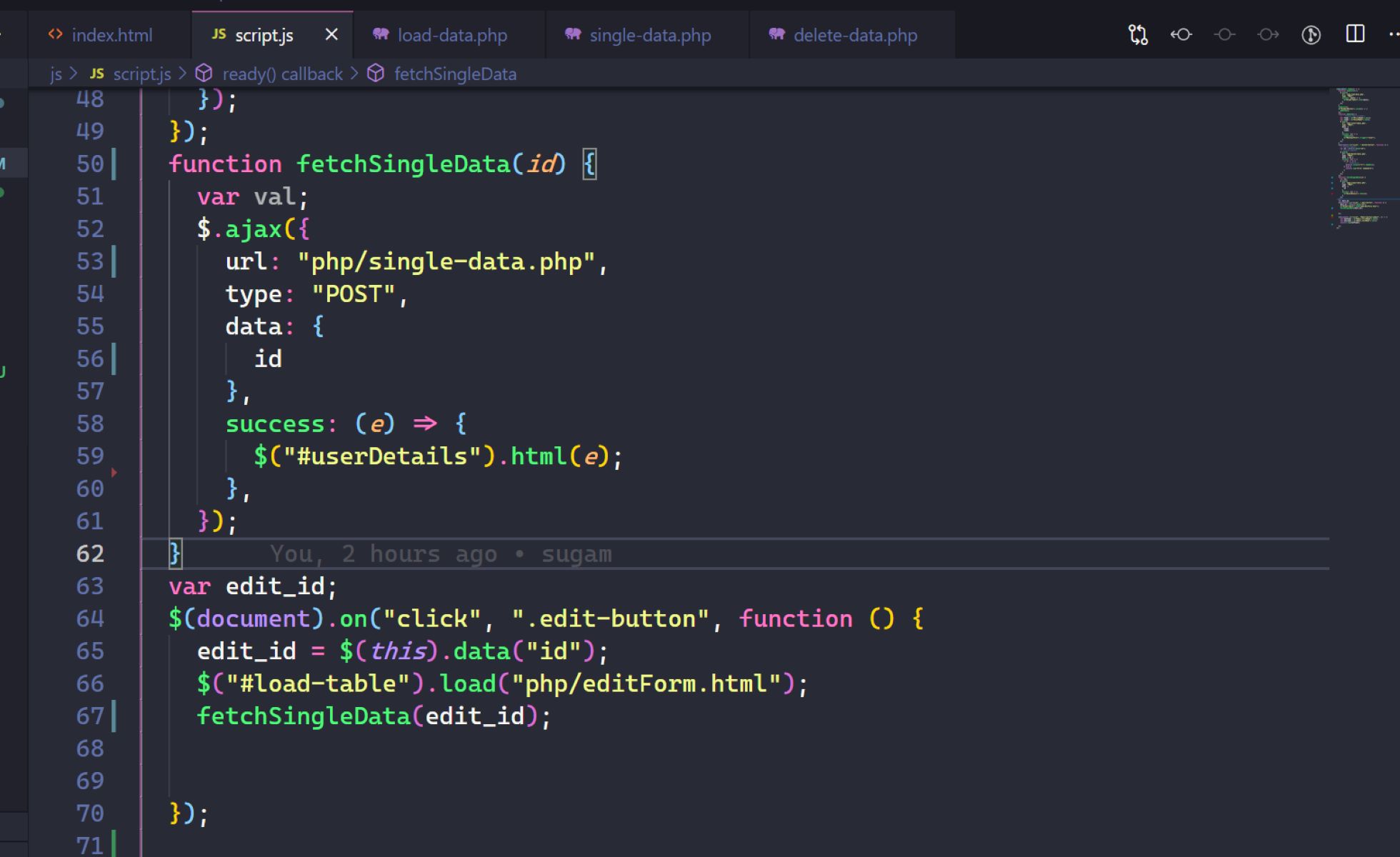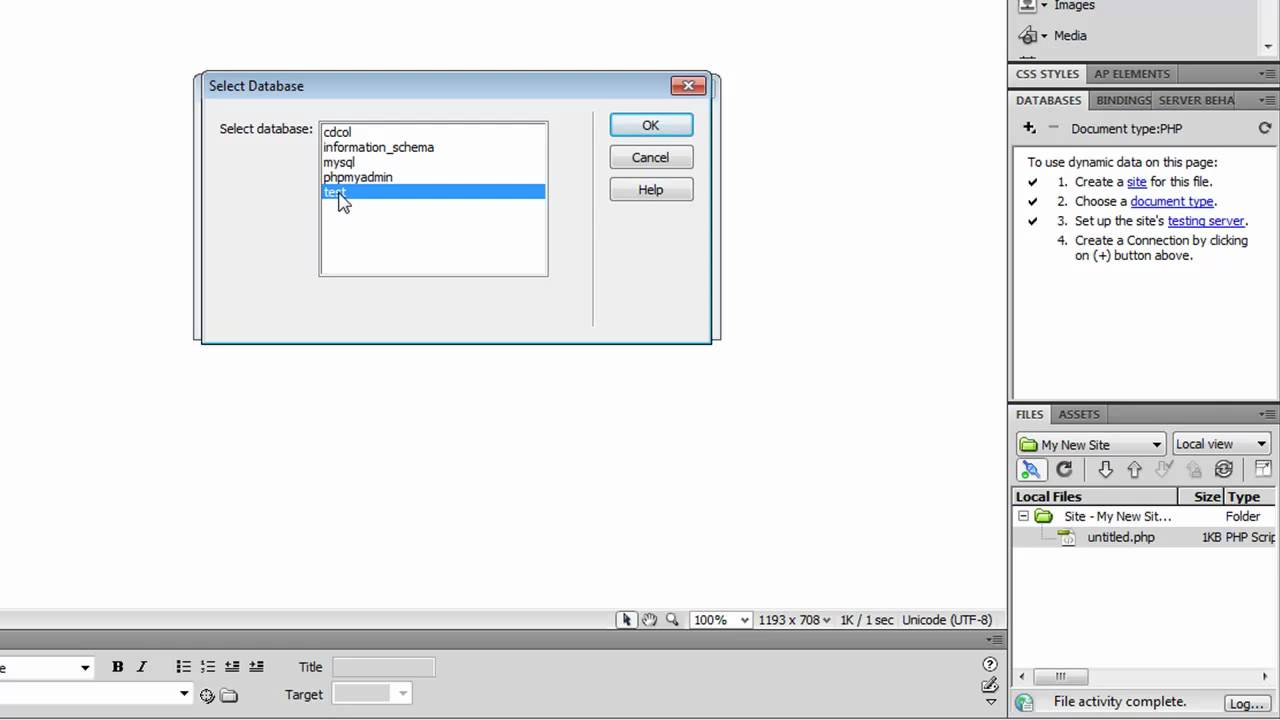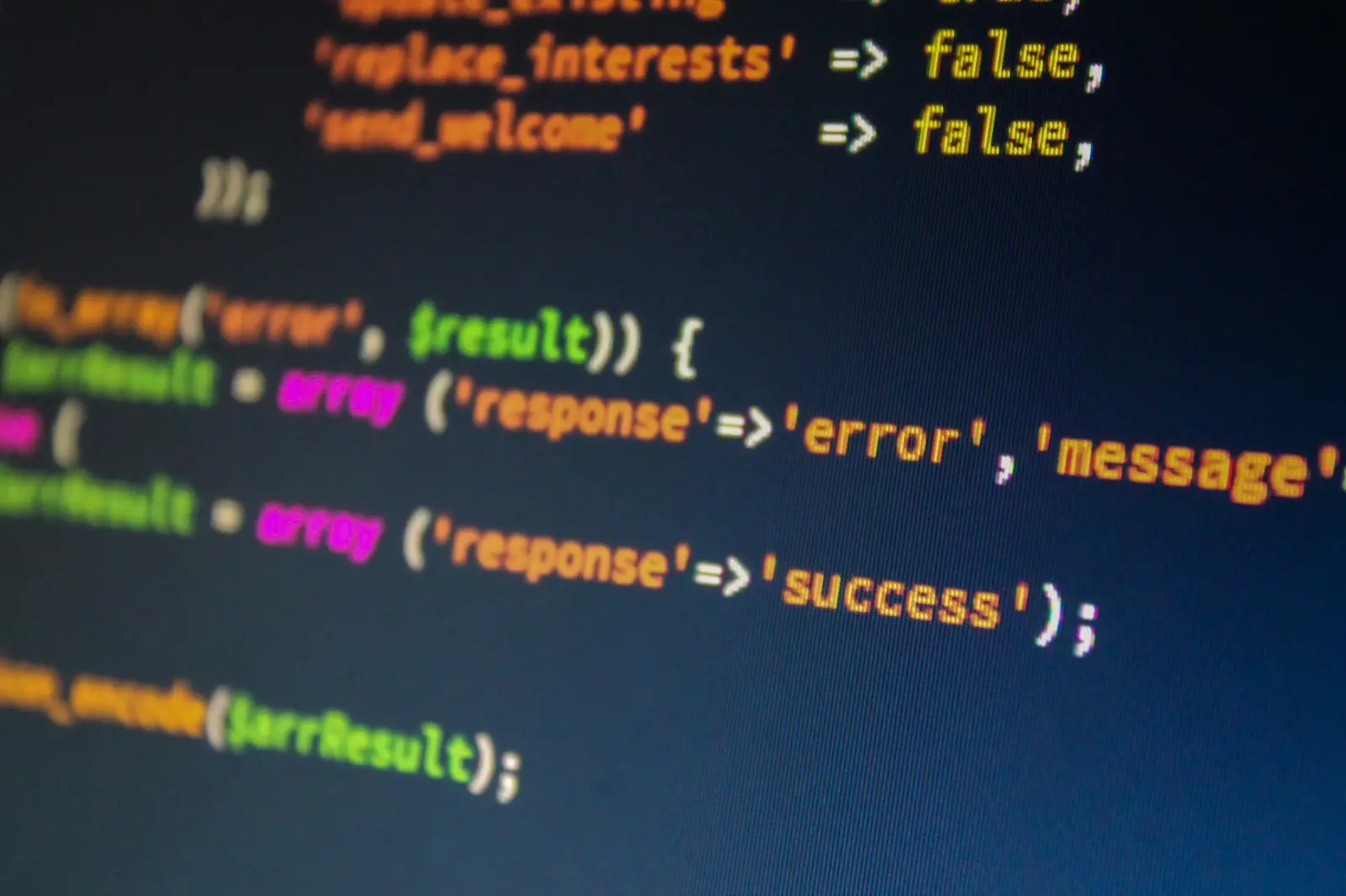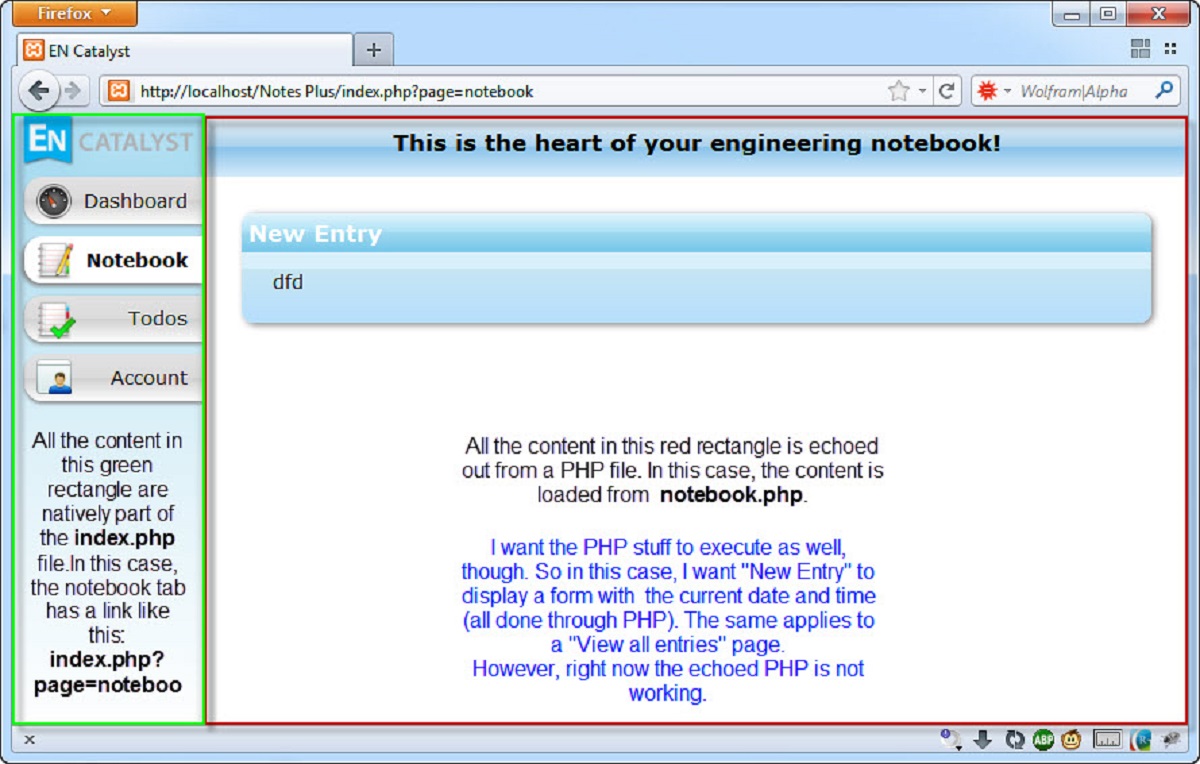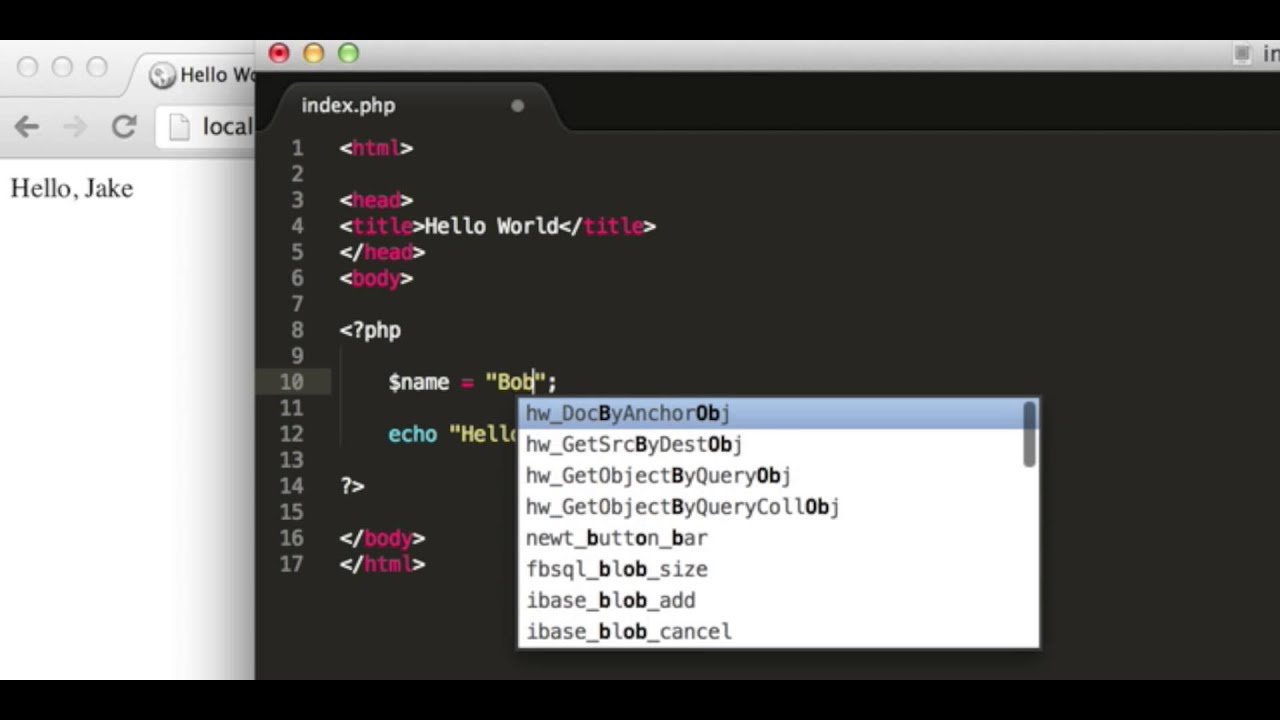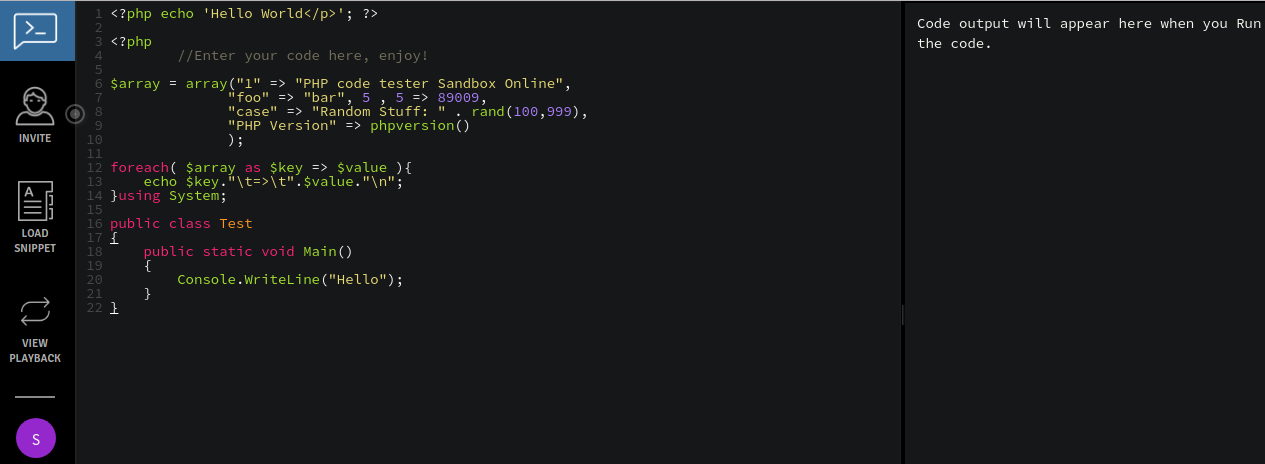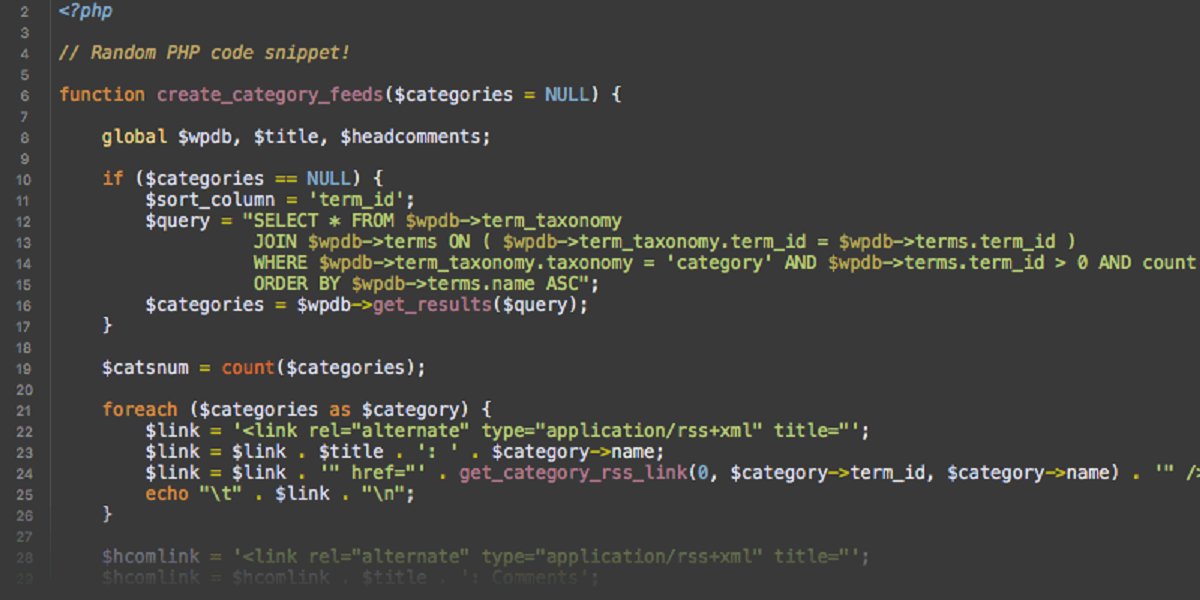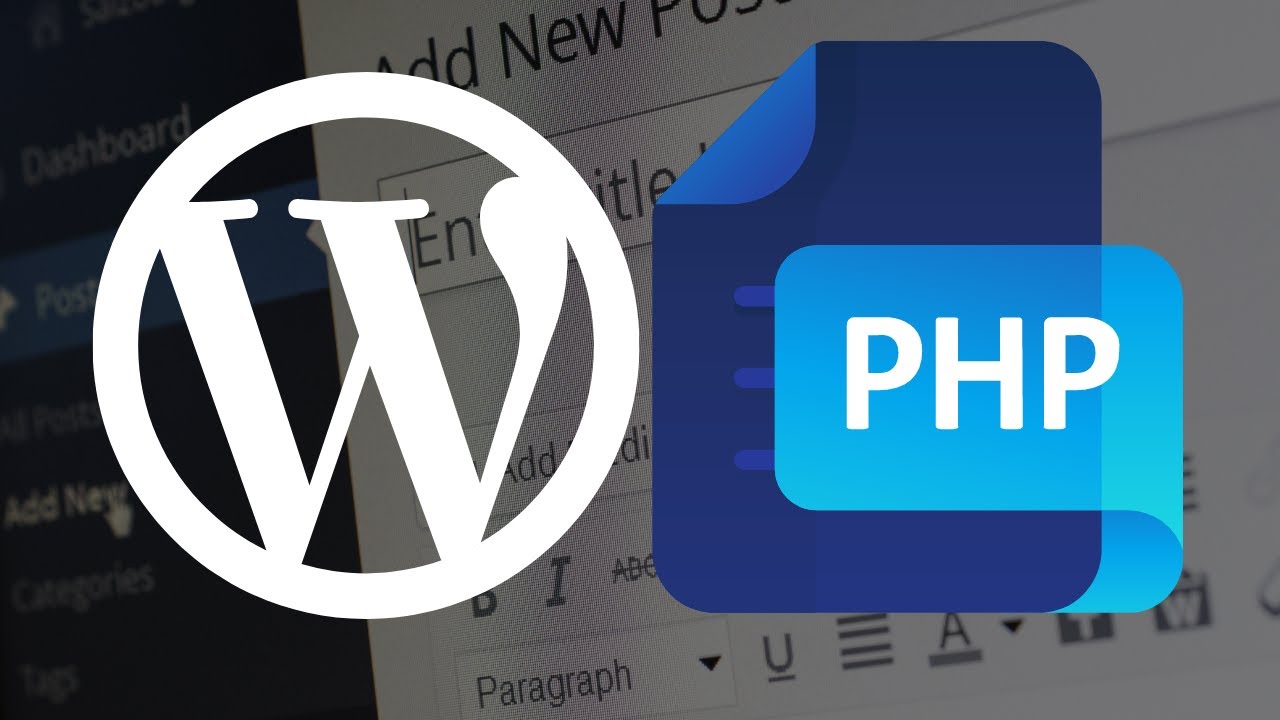Introduction
PHP, which stands for Hypertext Preprocessor, is a powerful and widely-used server-side scripting language that is designed for web development. It is a versatile language that allows developers to create dynamic and interactive web pages and applications. PHP is renowned for its simplicity, flexibility, and ease of use, making it a popular choice among developers of all levels of expertise.
Since its creation in 1994 by Danish-Canadian programmer Rasmus Lerdorf, PHP has evolved into a robust programming language that is used by millions of websites worldwide. It has become an integral part of web development and is supported by a vast community of developers who contribute to its growth and advancement.
One of the key reasons for the popularity of PHP is its compatibility with various operating systems like Windows, macOS, Linux, and Unix. It also supports a wide range of web servers, including Apache, Nginx, and Microsoft IIS, making it highly versatile and adaptable to different environments.
Moreover, PHP seamlessly integrates with HTML, allowing developers to embed PHP code directly within HTML pages. This enables the creation of dynamic web content that can interact with databases, handle form data, process user input, and perform various other tasks.
In this article, we will explore the fundamentals of PHP coding, ranging from its basic syntax and data types to more advanced concepts like object-oriented programming, file handling, and database connectivity. Whether you are a beginner looking to get started with PHP or an experienced developer seeking to deepen your understanding, this article will serve as a comprehensive guide to PHP coding.
What is PHP?
PHP is a popular server-side scripting language that is primarily used for web development. The acronym PHP initially stood for Personal Home Page, reflecting its origins as a tool for managing personal websites. Over time, PHP has evolved into a powerful scripting language capable of creating dynamic and interactive web applications.
Unlike client-side languages like HTML and CSS, which are executed by the user’s browser, PHP is executed on the server. This means that the server processes the PHP code and generates HTML that is sent to the user’s browser, resulting in a dynamic web page.
PHP is open-source and freely available, making it accessible to developers without any licensing costs. It provides extensive support for various databases, including MySQL, PostgreSQL, Oracle, and Microsoft SQL Server, allowing developers to easily interact with data.
One of the main strengths of PHP lies in its simplicity and ease of use. Its syntax is similar to that of C and Perl, making it approachable for developers with a background in those languages. Furthermore, PHP integrates seamlessly with HTML, allowing developers to embed PHP code directly within HTML files. This combination of PHP and HTML, known as server-side includes, enables the creation of dynamic web pages that can display dynamic content, process form data, and perform various other tasks.
Additionally, PHP offers extensive functionality through its vast collection of prebuilt functions. These functions cover a wide range of tasks, including string manipulation, file handling, database access, and more. Moreover, PHP supports the creation of custom functions, allowing developers to encapsulate reusable blocks of code and improve code maintainability.
Overall, PHP has gained immense popularity in the web development community due to its versatility, simplicity, and extensive functionality. It remains one of the top choices for developers when it comes to creating dynamic and interactive web applications.
Why is PHP so popular?
PHP has garnered immense popularity among web developers worldwide, and there are several reasons why it remains one of the most widely-used server-side scripting languages:
1. Ease of Use: PHP has a relatively low learning curve compared to other programming languages. Its syntax is user-friendly and resembles C, making it easily accessible for beginners. Additionally, PHP integrates seamlessly with HTML, allowing developers to write dynamic code within their HTML files, making it convenient for web development.
2. Large Community and Resources: PHP has a vast and supportive community of developers. This means there are plenty of online resources, tutorials, libraries, and frameworks available to assist developers in their PHP projects. The community also actively contributes to the development and improvement of PHP, ensuring that it remains up-to-date with evolving web technologies.
3. Cross-Platform Compatibility: PHP is compatible with various operating systems, including Windows, macOS, Linux, and Unix. It also supports a wide range of web servers such as Apache, Nginx, and Microsoft IIS. This cross-platform compatibility makes PHP highly versatile and allows developers to deploy their applications on different environments without significant changes.
4. Extensive Database Support: PHP has extensive support for various databases, including MySQL, PostgreSQL, Oracle, and Microsoft SQL Server. This allows developers to easily connect to databases, execute queries, and retrieve data, making it ideal for creating dynamic and data-driven web applications.
5. Flexibility and Scalability: PHP offers great flexibility in terms of code organization and project structure. It can be used for both small-scale websites and large-scale enterprise applications. Additionally, PHP supports modular development, allowing developers to reuse code and create maintainable and scalable applications. This flexibility is crucial in handling the growth and evolving needs of web projects.
6. Rich Functionality: PHP comes with a vast collection of built-in functions for various tasks such as string manipulation, file handling, database access, and more. These functions simplify common programming tasks and save developers time and effort. Additionally, PHP supports the creation of custom functions, enabling developers to encapsulate reusable code and improve code readability and maintainability.
In summary, PHP’s popularity can be attributed to its ease of use, strong community support, cross-platform compatibility, extensive database support, flexibility, scalability, and rich functionality. These factors have made PHP a reliable and preferred choice for web development, ensuring its continued prominence in the field.
How does PHP work?
PHP works as a server-side scripting language, meaning it is executed on the server before sending the resulting HTML to the user’s browser. Let’s take a closer look at how PHP functions:
1. Client Sends a Request: When a user requests a web page that contains PHP code, the request is sent to the server hosting the website.
2. Server Receives the Request: The server receives the request and identifies that the page being requested contains PHP code.
3. PHP Interpreter Processes the Code: The server’s PHP interpreter processes the PHP code embedded within the HTML. It interprets and executes the code line-by-line, carrying out the specified actions or operations.
4. Dynamic HTML Generation: As the PHP code is executed, it generates dynamic content or performs specific tasks based on the logic defined in the code. This could include database queries, form processing, calculations, or any other server-side operations.
5. HTML Output Sent to the Browser: Once the PHP interpreter completes executing the code, it generates HTML output. This output, along with any other static HTML or content, is then sent back to the user’s browser as a response to the initial request.
6. User’s Browser Renders the Web Page: The user’s browser receives the HTML output and renders it, displaying the final web page with any dynamic content, functionality, or data generated by the PHP code.
Overall, PHP provides a powerful mechanism for generating dynamic web content by allowing developers to embed PHP code within HTML. This combination of PHP and HTML enables the creation of dynamic, interactive, and personalized web pages.
It’s important to note that PHP can do much more than just dynamically generate HTML. It can also interact with databases, handle file uploads and downloads, send emails, authenticate users, and perform a wide range of other server-side operations. Its flexibility and versatility make it a popular choice for creating robust and feature-rich web applications.
Setting up a PHP environment
In order to develop and run PHP applications, you need to set up a PHP environment on your computer. Follow these steps to get started:
1. Choose a Web Server: The first step is to select a web server that will execute your PHP code. Apache, Nginx, and Microsoft IIS are popular choices. Choose the one that best suits your needs and install it on your computer.
2. Install PHP: Next, you’ll need to install PHP on your computer. PHP can be downloaded from the official PHP website (www.php.net) in the form of a precompiled binary for your specific operating system.
3. Configure the Web Server: Once PHP is installed, you need to configure the web server to recognize PHP files and pass them to the PHP interpreter. This involves updating the server’s configuration files. The specific steps may vary depending on the web server you have chosen.
4. Test the Setup: After configuring the web server, you should test if PHP is working correctly. Create a simple PHP file, such as “test.php”, containing the following code: ``. Save the file in the web server’s document root directory and access it from your browser using the URL: `http://localhost/test.php`. If PHP is configured correctly, you will see a detailed information page about your PHP installation.
5. Choose a Development Environment: To make coding easier, you can choose a suitable integrated development environment (IDE) for PHP. IDEs like PhpStorm, Visual Studio Code, and NetBeans provide features such as code highlighting, code completion, and debugging capabilities, enhancing your productivity as a PHP developer.
6. Install a Database Server (Optional): If your PHP application requires database functionality, you might need to install a database server. Popular options include MySQL, PostgreSQL, and SQLite. Install the appropriate database server and configure it to work with PHP.
7. Learn PHP: With your PHP environment set up, you are now ready to start learning and coding in PHP. Familiarize yourself with the PHP syntax, language constructs, and best practices. Explore the vast resources available online, including documentation, tutorials, and code examples.
Setting up a PHP environment may initially seem complex, but once you have everything configured correctly, you’ll have a powerful platform to develop and test your PHP applications. A well-configured PHP environment will enable you to create dynamic and interactive web pages and applications with ease.
Basic syntax of PHP
The syntax of PHP is straightforward and easy to learn, making it a user-friendly scripting language for web development. Here are the key elements of PHP’s basic syntax:
Opening and Closing Tags: PHP code is placed within opening (<?php) and closing (?>) tags. This tells the server where the PHP code begins and ends.
Comments: PHP supports both single-line and multi-line comments. Single-line comments start with // and continue until the end of the line. Multi-line comments begin with /* and end with */.
Variables: PHP variables are declared with the $ symbol followed by the variable name. Variables in PHP are loosely typed, meaning they don’t have fixed data types and can be dynamically assigned values of different types.
Output: To display content or variables on a web page, you can use the echo or print statement. For example, echo "Hello, World!"; will output the text “Hello, World!” to the browser.
Operators: PHP supports a wide range of operators, such as arithmetic, assignment, comparison, logical, and concatenation operators. These operators perform mathematical calculations, assign values, compare values, evaluate conditions, and construct strings.
Conditional Statements: PHP provides conditional statements like if, else if, and else to make decisions based on certain conditions. These statements allow you to execute different blocks of code based on the evaluation of specific conditions.
Loops: PHP offers loop structures like for, while, and foreach to repeat a block of code multiple times. These loops are helpful for iterating over arrays, processing data, and controlling the flow of your code.
Functions: PHP supports the creation of reusable code blocks called functions. Functions encapsulate a set of actions and can be called multiple times throughout your code. They help to enhance code organization, reduce duplication, and improve code readability.
Include and Require: PHP allows you to include external files using the include or require statements. This enables you to reuse code from other files, providing modular code structure and promoting code reuse.
These are just a few examples of the basic syntax elements in PHP. As you delve deeper into PHP development, you will encounter more advanced concepts like arrays, classes, and error handling. Mastering the basic syntax will provide a strong foundation for understanding these advanced concepts and enable you to develop robust and efficient PHP applications.
Variables in PHP
Variables are fundamental components of any programming language, including PHP. In PHP, variables are used to store and manipulate data. Here’s what you need to know about variables in PHP:
Variable Naming: PHP variable names start with the $ symbol, followed by the name itself. The name can consist of letters, numbers, and underscores, but it must start with a letter or underscore. Variable names are case-sensitive, meaning $name and $Name are considered different variables.
Variable Assignment: Assigning a value to a variable is as simple as using the assignment operator (=). For example, $name = "John Doe"; assigns the string “John Doe” to the variable named $name.
Variable Data Types: PHP is loosely typed, meaning variables are not bound to specific data types. They can hold different types of values, such as strings, numbers, booleans, arrays, and objects. PHP automatically converts variables based on the context in which they are used.
Variable Scope: PHP supports both local and global variable scope. Variables declared within a function have local scope, meaning they can only be accessed within that function. Variables declared outside of any function have global scope and can be accessed from anywhere.
Variable Concatenation: PHP uses the concatenation operator (.) to combine strings and variables. For example, $message = "Hello, " . $name; will concatenate the value of the $name variable with the string “Hello, “.
Variable Interpolation: PHP allows variable interpolation within double-quoted strings. When a variable is included in a double-quoted string, its value is automatically substituted. For example, $age = 25; echo "I am $age years old"; will output “I am 25 years old”.
Variable Manipulation: PHP provides numerous built-in functions for manipulating variables. You can modify strings, convert data types, format numbers, and perform various other operations on variables using these functions.
Constants: PHP also supports defining constants, which are similar to variables but their values cannot be changed once defined. Constants are defined using the define() function and are typically used for storing fixed values that remain constant throughout the execution of a script.
Understanding variables and their usage is vital in PHP development. They allow you to store and manipulate data dynamically, making your code flexible and powerful. Whether you’re working with user input, database queries, or any form of data manipulation, variables play a key role in creating dynamic and interactive PHP applications.
Data types in PHP
PHP supports various data types that allow developers to store and manipulate different kinds of data. Understanding data types is crucial for effectively working with variables and performing operations on them. Here are the commonly used data types in PHP:
1. String: Strings represent sequences of characters and are enclosed in single quotes (' ') or double quotes (" "). PHP provides numerous string manipulation functions for tasks like concatenation, searching, replacing, and formatting.
2. Integer: Integers are whole numbers without decimal points. They can be positive or negative and have no size limit. PHP supports arithmetic operations on integers, making it suitable for mathematical calculations.
3. Float: Float, also known as double or floating-point numbers, represent decimal numbers with precision. They are used for scientific calculations, measurements, and financial computations. Floats are written with the decimal point or in scientific notation (e.g., 3.14159 or 1.2e3).
4. Boolean: Booleans represent two states: true or false. They are often used in conditional statements and comparisons. PHP automatically converts values to booleans based on their truthiness; for example, 0 and empty strings are considered false, while other values are considered true.
5. Array: Arrays are used to store multiple values in a single variable. PHP supports indexed arrays (numerically indexed) and associative arrays (key-value pairs). Arrays can contain values of any data type, and elements can be added, modified, or removed dynamically.
6. Object: Objects represent instances of classes and allow for the implementation of object-oriented programming in PHP. Objects encapsulate data and behavior within methods and properties, providing a structured approach to programming.
7. NULL: NULL represents the absence of a value. It is often used to indicate that a variable has no assigned value. Assigning null to a variable signifies that it has no data type or value assigned to it.
8. Resource: Resources are special variables that hold references to external resources, such as database connections or file handles. They are created and managed by PHP’s built-in functions and extensions.
9. Callable: Callable variables store references to functions or methods and allow them to be called dynamically. Callables are commonly used to pass functions as arguments or use them as callbacks.
Understanding the different data types in PHP enables you to handle and manipulate data effectively. It is essential to choose the appropriate data type based on the requirements of your application to ensure accurate results and efficient code execution.
Conditional statements in PHP
Conditional statements allow you to control the flow of your PHP code based on specific conditions. They enable you to make decisions and execute different blocks of code depending on the evaluation of these conditions. Here are the conditional statements supported by PHP:
1. if statement: The if statement is the most basic conditional statement. It allows you to execute a block of code if a certain condition is true. If the condition is false, the code block is skipped. The syntax is as follows:
php
if (condition) {
// code to be executed if the condition is true
}
2. if…else statement: The if...else statement adds an additional block of code that executes if the condition of the if statement is false. This allows for two distinct blocks of code to be executed based on the evaluation of a condition. The syntax is as follows:
php
if (condition) {
// code to be executed if the condition is true
} else {
// code to be executed if the condition is false
}
3. else if statement: The else if statement is used to check multiple conditions in sequence. It allows for multiple code blocks to be executed based on different conditions. The syntax is as follows:
php
if (condition1) {
// code to be executed if condition1 is true
} else if (condition2) {
// code to be executed if condition2 is true
} else {
// code to be executed if all conditions are false
}
4. switch statement: The switch statement provides an alternative way to handle multiple conditions. It allows you to compare a value against multiple possible cases and execute the code block associated with the matching case. The syntax is as follows:
php
switch (variable) {
case value1:
// code to be executed if the variable matches value1
break;
case value2:
// code to be executed if the variable matches value2
break;
default:
// code to be executed if none of the cases match
break;
}
Conditional statements are essential for making decisions in your PHP code. They provide the flexibility to execute different blocks of code based on specific conditions, allowing for dynamic behavior and personalized output in your web applications.
Loops in PHP
Loops are essential for executing a block of code multiple times. They allow you to iterate over a set of values, perform repetitive tasks, and control the flow of your PHP code. PHP provides several types of loops to cater to different looping requirements. Here are the various loop structures in PHP:
1. for loop: The for loop is used when you know the number of iterations in advance. It has three segments: initialization, condition check, and increment/decrement. The loop continues as long as the condition is true. The syntax is as follows:
php
for (initialization; condition; increment/decrement) {
// code to be executed in each iteration
}
2. while loop: The while loop is used when the number of iterations is unknown beforehand. It continues to execute as long as the specified condition evaluates to true. The syntax is as follows:
php
while (condition) {
// code to be executed in each iteration
}
3. do…while loop: The do...while loop is similar to the while loop, but it executes the code block at least once before checking the condition. It will continue to execute as long as the condition remains true. The syntax is as follows:
php
do {
// code to be executed in each iteration
} while (condition);
4. foreach loop: The foreach loop is used specifically for iterating over arrays. It automatically assigns each element of an array to a specified variable in each iteration. The syntax is as follows:
php
foreach ($array as $value) {
// code to be executed in each iteration
}
5. break statement: Within a loop, the break statement is used to exit the loop prematurely, skipping the rest of the iterations. It is commonly used to terminate a loop based on a specific condition or when a desired outcome is achieved.
6. continue statement: The continue statement is used to skip the rest of the code within a loop for the current iteration and move to the next iteration. It is typically used to skip certain iterations based on specific conditions.
Loops are invaluable in executing repetitive tasks and processing sets of data. They allow you to automate tasks, iterate over arrays, and perform other operations efficiently within your PHP code. Understanding how to utilize loops effectively can greatly enhance the functionality and efficiency of your PHP applications.
Arrays in PHP
Arrays are essential data structures in PHP that allow you to store multiple values in a single variable. They provide a convenient way to work with collections of data and enable efficient manipulation and iteration. Here’s what you need to know about arrays in PHP:
Creating an Array: In PHP, an array can be created using the array() construct or by using square brackets ([]) for short syntax. For example:
php
$fruits = array(“apple”, “banana”, “orange”);
// or
$fruits = [“apple”, “banana”, “orange”];
Accessing Array Elements: Array elements are accessed using their corresponding index. The index starts at 0 for the first element, and subsequent elements are accessed by incrementing the index. For example:
php
echo $fruits[0]; // Output: apple
echo $fruits[1]; // Output: banana
echo $fruits[2]; // Output: orange
Modifying Array Elements: Array elements can be modified by assigning a new value to a specific index. For example:
php
$fruits[1] = “grape”;
echo $fruits[1]; // Output: grape
Array Length: To determine the length or size of an array, you can use the count() function. For example:
php
echo count($fruits); // Output: 3
Iterating Over Arrays: PHP provides several methods to iterate over array elements. The most common one is the foreach loop. It automatically iterates through each element of an array without needing to manage the index manually. For example:
php
foreach ($fruits as $fruit) {
echo $fruit . “, “;
}
// Output: apple, banana, orange,
Associative Arrays: PHP also supports associative arrays, where each element has a unique key instead of the traditional numeric index. This allows you to access elements using a specific key. For example:
php
$student = [
“name” => “John”,
“age” => 25,
“grade” => “A”
];
echo $student[“name”]; // Output: John
echo $student[“age”]; // Output: 25
echo $student[“grade”];// Output: A
Array Functions: PHP offers a wide range of built-in array functions to perform common operations like sorting, filtering, merging, and more. These functions provide flexibility and efficiency when working with arrays.
Arrays are powerful and versatile data structures in PHP that allow you to organize and manipulate collections of values. They are widely used in various scenarios such as storing lists of items, managing form data, processing database results, and more. Understanding arrays and their functions enables efficient and effective data handling in your PHP applications.
Functions in PHP
Functions in PHP are reusable blocks of code that perform specific tasks. They provide a way to organize code, improve code maintainability, and promote code reusability. Here’s what you need to know about functions in PHP:
Defining a Function: A function is defined using the function keyword, followed by the function name and a pair of parentheses. The function body is enclosed in curly braces. For example:
php
function greet() {
echo “Hello, World!”;
}
Calling a Function: To execute a function and run the code inside it, you simply call the function by using its name followed by parentheses. For example:
php
greet(); // Output: Hello, World!
Function Parameters: Functions can accept parameters, which are variables that hold values passed into the function. Parameters are declared inside the parentheses when defining the function. For example:
php
function greet($name) {
echo “Hello, ” . $name . “!”;
}
greet(“John”); // Output: Hello, John!
Returning a Value: Functions can return a value using the return statement. The returned value can be used in other parts of the program. For example:
php
function add($num1, $num2) {
return $num1 + $num2;
}
$result = add(4, 5);
echo $result; // Output: 9
Default Parameters: Functions can have default parameter values. If a parameter is not provided when the function is called, the default value will be used. For example:
php
function greet($name = “World”) {
echo “Hello, ” . $name . “!”;
}
greet(); // Output: Hello, World!
greet(“John”); // Output: Hello, John!
Variable Scope: Variables declared within a function have local scope and are only accessible within that function. However, you can make use of the global keyword to access variables from outside the function. Additionally, you can use the static keyword to retain variable values across multiple function calls.
Built-in Functions: PHP provides a vast collection of built-in functions that perform various tasks, such as string manipulation, mathematical calculations, date and time manipulation, and more. These functions save time and effort by providing pre-built functionality.
Functions are an essential part of PHP development. They allow you to break down complex tasks into smaller, manageable chunks of code. By utilizing functions effectively, you can improve code organization, maintainability, and reusability across your PHP applications.
Object-oriented programming in PHP
Object-oriented programming (OOP) is a programming paradigm that allows developers to create reusable and modular code by organizing data and behavior into objects. PHP supports OOP, providing powerful features to build robust and scalable applications. Here’s what you need to know about object-oriented programming in PHP:
Classes and Objects: In OOP, a class is a blueprint or template that defines the structure and behavior of objects. Objects are instances of a class that contain properties (variables) and methods (functions) to represent real-world entities. Classes are defined using the class keyword. For example:
php
class Person {
public $name;
public $age;
public function greet() {
echo “Hello, my name is ” . $this->name . “.”;
}
}
Access Modifiers: PHP supports access modifiers to control the visibility of properties and methods. The three access modifiers are public, private, and protected. Public allows properties and methods to be accessed from anywhere, while private restricts access only to within the class itself. Protected allows access within the class and its subclasses.
Constructor: The constructor method is a special method that is automatically called when an object is created from a class. It is used to initialize object properties and perform any necessary setup. The constructor method in PHP is named __construct(). For example:
php
class Person {
public $name;
public $age;
public function __construct($name, $age) {
$this->name = $name;
$this->age = $age;
}
}
Inheritance: Inheritance allows classes to inherit properties and methods from parent classes. It enables code reuse and promotes modular programming. Child classes inherit the behavior of the parent class and can override or extend it. In PHP, inheritance is achieved using the extends keyword. For example:
php
class Student extends Person {
public $grade;
public function study() {
echo $this->name . ” is studying.”;
}
}
Polymorphism: Polymorphism allows objects of different classes to be treated as objects of a common parent class. It enables flexibility and enables the use of different implementations for the same method name. Polymorphism is achieved through method overriding and interfaces in PHP.
Encapsulation: Encapsulation is the practice of hiding internal implementation details and providing a public interface to interact with objects. It enhances code maintainability and protects the integrity of data. Access modifiers help in implementing encapsulation.
Static Keyword: The static keyword allows properties and methods to be accessed without the need for an instance of the class. Static properties and methods belong to the class itself, rather than individual objects. They can be accessed using the class name. For example:
php
class MathUtils {
public static function add($num1, $num2) {
return $num1 + $num2;
}
}
echo MathUtils::add(4, 5); // Output: 9
OOP provides a structured and efficient way to build complex PHP applications. By utilizing classes, objects, inheritance, encapsulation, and other OOP principles, you can create modular, maintainable, and extensible code that is easier to understand and work with.
File handling in PHP
File handling is an important aspect of many PHP applications, whether it involves reading from or writing to files. PHP provides several functions and techniques to handle file operations efficiently. Here’s what you need to know about file handling in PHP:
Opening and Closing Files: To perform file operations, you need to open the file first using the fopen() function, which takes two parameters: the file path and the mode. The mode specifies the type of operation you want to perform, such as read, write, or append. Once you’re done with the file, it should be closed using the fclose() function.
Reading from Files: PHP offers multiple functions for reading from files, including fread(), fgets(), and file(). fread() reads a specified number of bytes, fgets() reads a line, and file() reads the entire file into an array, with each element representing a line of the file.
Writing to Files: Writing to files can be done using functions such as fwrite() or file_put_contents(). fwrite() writes a specified string to the file, while file_put_contents() writes the entire contents of a string to the file.
Appending to Files: To add content to an existing file without overwriting its previous content, you can use the fopen() function with the mode parameter set to "a", which stands for append.
File Pointer: When reading or writing to a file, PHP uses a file pointer, which keeps track of the current position in the file. The pointer is automatically moved forward after each read or write operation.
Checking for End-of-File: PHP provides the feof() function to check if the end of a file has been reached. This function returns true if the end of the file has been reached, and false otherwise.
Error Handling: It’s important to handle errors that may occur during file operations. PHP offers various error handling functions, such as file_exists(), is_readable(), and is_writable(), to check if a file exists, is readable, or is writable before performing file operations.
Working with Directories: PHP provides functions like mkdir() to create directories and rmdir() to remove directories. Additionally, there are functions like scandir() and glob() to retrieve file and directory lists within a directory.
File handling is an essential part of many PHP applications, whether it involves reading configuration files, writing logs, or manipulating data stored in files. Understanding the various file handling functions and techniques in PHP empowers you to perform efficient file operations and effectively manage data stored in files.
Database connectivity in PHP
Database connectivity is a critical aspect of many web applications, enabling the storage and retrieval of data. PHP provides extensive support for connecting to databases, executing queries, and manipulating data. Here’s what you need to know about database connectivity in PHP:
Connecting to a Database: PHP supports various database systems, including MySQL, PostgreSQL, SQLite, and more. To connect to a database, you need to use the appropriate database extension and supply the necessary connection details, such as the server name, database name, username, and password.
Executing Queries: PHP allows you to execute SQL queries against the connected database using functions such as mysqli_query() or pdo->query(). These functions can execute both data retrieval queries (SELECT) and data manipulation queries (INSERT, UPDATE, DELETE).
Data Retrieval: PHP offers functions to fetch data from database query results, such as mysqli_fetch_assoc(), mysqli_fetch_array(), or pdo->fetch(). These functions retrieve one row of data at a time, and you can iterate over the result set to access all the returned data.
Prepared Statements: Prepared statements provide a way to execute SQL queries with parameterized values. This helps prevent SQL injection attacks and enhances the security of your application. PHP supports prepared statements through functions like mysqli_prepare() and pdo->prepare().
Error Handling: It’s crucial to handle any errors that may arise during database operations. PHP provides functions such as mysqli_error(), pdo->errorInfo(), and try...catch blocks for effective error handling, enabling you to identify and resolve issues with database connectivity or queries.
Transaction Management: PHP supports transactions, which allow a group of database operations to be treated as a single unit. Transactions ensure data integrity and consistency by enabling operations to be either committed or rolled back in case of an error or failure.
Database Abstraction: PHP provides database abstraction layers like PDO (PHP Data Objects) that offer a consistent API for connecting to and working with different database systems. Database abstraction allows for flexibility in switching between databases without changing the code significantly.
Database connectivity is essential for web applications that require persistent data storage. With PHP’s robust database connectivity capabilities, you can seamlessly connect to databases, execute queries, retrieve and manipulate data, and ensure the security and integrity of your application’s data.
Conclusion
In this article, we have explored the fundamental aspects of PHP coding. PHP, a versatile server-side scripting language, offers a wide range of features and capabilities that make it a preferred choice for web development. From understanding the basics of PHP syntax and data types to mastering concepts like conditional statements, loops, arrays, and functions, we have covered the core elements of PHP programming.
PHP’s simplicity, flexibility, and extensive community support contribute to its wide popularity. Its compatibility with different operating systems and web servers, seamless integration with HTML, and support for various databases make it a robust and versatile language for developing dynamic web applications. With a strong understanding of PHP, developers can create interactive websites, handle file operations, establish database connections, and perform various other tasks necessary for web development.
As you continue your journey in PHP development, remember to follow best practices, stay updated with the latest PHP versions and functionalities, and leverage online resources and communities to enhance your skills. Regular practice and exploration of real-world projects will further solidify your knowledge of PHP coding.
By harnessing the power of PHP, you can unleash your creativity and build dynamic, efficient, and engaging web applications that meet the needs of users.







